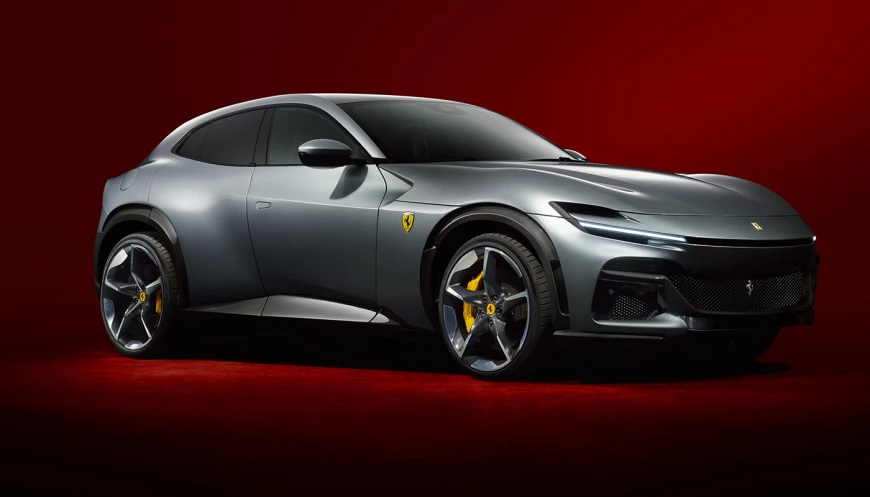Ferrari Purosangue
The Ferrari Purosangue is the Prancing Horse's first ever four-door four-seater SUV that might take Ferrari in a new direction.
 Photos by Ferrari S.p.A.
Photos by Ferrari S.p.A.
After years of anticipation by the international automotive fraternity, Ferrari today unveiled the Purosangue, the first ever four-door, four-seater car in the Prancing Horse's 75-year history.
Since the marque's earliest years, 2+2 cars (i.e. with two front and two smaller back seats) have played a significant role in its strategy. Many Ferraris have made combining benchmark performance with first-class comfort one of the pillars of their success. Now, in the culmination of 75 years of leading-edge research, Ferrari has created a car that is unique on the world stage: not only do performance, driving pleasure and comfort coexist in perfect harmony, but it is also a peerless encapsulation of the Prancing Horse's iconic DNA. This is the reason why the name Purosangue, Italian for thoroughbred, was chosen.
To enable the company to achieve the ambitious goals set for this project and create a car worthy of a place in its range, a completely different layout, and innovative proportions compared to modern GT archetypes (so-called crossovers and SUVs) were adopted. The average modern GT's engine is mounted forwards in the car, almost straddling the front axle with the gearbox coupled directly to it; this results in less than optimal weight distribution that delivers driving dynamics and driving pleasure well short of the standards of excellence to which Prancing Horse clients and enthusiasts have become accustomed.

The Purosangue, on the other hand, has a mid-front-mounted engine with a gearbox at the rear to create a sporty transaxle layout. The Power Transfer Unit (PTU) is coupled in front of the engine to provide a unique 4x4 transmission. This delivers exactly the 49:51% weight distribution that Maranello's engineers deem optimal for a mid-front-engined sports car.
The Purosangue stands head and shoulders above the rest of the market thanks to its performance and comfort. It is the only car with these proportions to sport a mid-front-mounted, naturally-aspirated V12. Maranello's most iconic engine debuts in this brand-new configuration to ensure the car unleashes more power than any other in the segment (725 cv) whilst guaranteeing the most enthralling Ferrari engine soundtrack. Furthermore, it can deliver 80% torque even at low revs for unique driving pleasure at all times.
The Purosangue's aero development focused on making the bodywork, underbody, and rear diffuser as efficient as possible. New solutions include synergy between the front bumper and wheel arch trim which generates an air curtain that aerodynamically seals the front wheels, preventing turbulent transverse air flows from being generated.
Ferrari has also given the Purosangue the very latest iterations of the vehicle dynamic control systems introduced on its most powerful and exclusive sports cars, including independent four-wheel steering and ABS ‘evo' with the 6-way Chassis Dynamic Sensor (6w-CDS). Making its world debut is the new Ferrari active suspension system. This very effectively controls body roll in corners as well as the tire contact patch over high-frequency bumps to deliver the same performance and handling response as in one of the marque's sports cars.

The all-new chassis has a carbon-fiber roof as standard to keep weight down and lower the center of gravity. Redesigning the bodyshell from scratch also meant the designers could incorporate rear-hinged back doors (welcome doors) to make ingress and egress easier while keeping the car as compact as possible. The cabin has four generous heated electric seats that will comfortably accommodate four adults. The boot is the largest ever seen on a Ferrari and the rear seats fold to increase the luggage space. Naturally enough, the Purosangue has a more commanding driving position than other Ferraris, but the configuration is the same as on every other Ferrari. As a result, the driving position is still intimate and close to the floor to provide a greater connection to the car's dynamic capabilities.
The Purosangue offers class-leading performance figures (from 0 to 100 km/h in 3.3 s and from 0 to 200 in 10.6 s); the driving position and the heady, naturally-aspirated V12 soundtrack deliver an entirely new yet also entirely Ferrari driving experience. The fact that a vast array of comfort-focused content is provided as standard, such as the Burmester audio system, and that the many optional extras including the brand-new Alcantara upholstery, derived from certified recycled polyester, make the Purosangue the most complete four-door, four-seater in the segment.
The Engine and why its a bit special
The Purosangue's engine (code-named F140IA) maintains the architecture that made the Prancing Horse's most recent 12-cylinders so successful i.e. a 65° angle between its cylinder banks, a 6.5-liter capacity, dry sump, and high-pressure direct injection. It was designed, however, to produce the highest amount of torque at low revs possible without losing the feeling of linear, never-ending power typical of Ferrari's naturally-aspirated V12s. 80% of the maximum torque is on tap at just 2100 rpm and it peaks at 716 Nm at 6250 rpm. Maximum power of 725 cv is reached at 7750 rpm and throttle response is characteristic of a real sports car.
Intake, timing, and exhaust systems have been completely redesigned, while the cylinder heads are derived from the 812 Competizione. Huge attention was lavished on improving mechanical and combustion efficiency, employing Formula 1-inspired calibration concepts. The result is that the most powerful engine ever developed by Ferrari for a four-seater car is also the most powerful in its segment, as well as the only one capable of delivering that instantly recognizable Ferrari V12 soundtrack.
To guarantee maximum mechanical efficiency, the rotating masses have been redesigned. The nitrided steel crankshaft was modified to lengthen the stroke and the internal oil passageways have been redesigned to improve oil flow to the big-end bearings. Lower bearing clearance tolerances improve consumption. The coolant and oil pump assembly was also redesigned focussing on the scavenge section to reduce friction and mass thanks to the adoption of smaller diameter rotors and optimizing the inlets and outlets as well as the rotor seals.

The valve train timing is all new, while the new finishing process for the camshafts has considerably reduced the surface roughness and the friction coefficient between the lobes, the shafts themselves, and the hydraulic tappets.
To optimize the torque curve and ensure a continual increase across the rev range, the geometry of the intake ducts and plenums was revised. The geometry of the exhaust system was also optimized to increase permeability and reduce back pressure. There are specific pistons with a redesigned crown to increase combustion efficiency.
The engine's direct injection system comprises two high-pressure fuel pumps (350 bar) that deliver petrol to the injectors in the combustion chambers. The ignition system, comprising 12 coils and spark plugs, is constantly monitored by the ECU which has an ion-sensing system that measures ionizing currents to control ignition timing. It has a single- and multi-spark function to make the combustion as efficient as possible at all revs. The ECU also controls combustion in the chamber to ensure that the engine is always working at peak thermodynamic efficiency, thanks to a sophisticated strategy that recognizes the octane rating (RON) of the fuel in the tank and adjusts the advance to suit. The engine strategy includes a new patented function derived from Ferrari's Formula expertise that optimizes the torque during transient acceleration maneuvers in the low and mid-range.

The F140IA's soundtrack is a superb example of integration between the glorious symphony created by the engine's combustion sequence and Ferrari's ability to control the acoustics in the cabin. The equal-length exhaust manifolds are tuned to guarantee the 12 cylinders are in perfect harmony. The new plenum with an optimized intake duct accompanies the V12's high notes with the body of the medium frequencies. The two progressive silencers, the response of which is now included in the Manettino settings, cater for in-town and performance driving. The resulting soundtrack is typical Ferrari, with that unmistakable V12 harmonics that are present, yet subtle, until the driver accelerates hard: as the engine approaches the 8250 rpm red-line, there's an enthralling crescendo that reaches its pinnacle at the kind of high revs only Ferrari's engines can deliver.
The layout of the 8-speed, oil-bath dual-clutch transmission was optimized through the adoption of a dry sump and a significantly more compact clutch assembly, shaving 15 mm off the installed height in the car which, in turn, lowers the center of gravity by the same amount. The new clutch's performance is 35% higher, transmitting up to 1200 Nm in dynamic torque during gear shifts. Thanks to new-generation actuation hydraulics, clutch fill times are now faster so total gear shift times have been reduced compared to the previous 7-speed DCT. New gear ratios mean that the spacings are shorter and very progressive, and a longer top ratio is geared for greater economy in motorway driving. Downshifts have been calibrated to optimize smooth shifting with a specific focus on driving pleasure and emphasizing the sound of the new V12 engine.
Find more Cars
The Bentley Bentayga
The Bentley Bentayga, the pinnacle, sector-defining new model, that combine...
BMW iX - A revolution
The BMW iX will be launched with a choice of two model variants. Both are e...
Rolls-Royce Cullinan - Inspired by Fashion
The House of Rolls-Royce reveals Cullinan - Inspired by Fashion, comprised ...
Two Powerhouses Roared into the Miami Internationa...
Mercedes-AMG and Cigarette Racing joined forces for the sixth consecutive y...
Maserati meets David Beckham
A letter written to the magical city of Miami: this is how MC20 Fuoriserie ...
The new Porsche 911 Sport Classic
The new Porsche 911 Sport Classic is the second of four collector's items t...




















